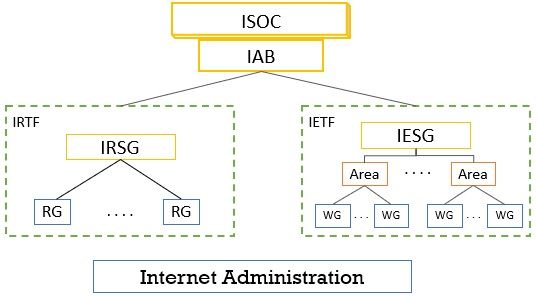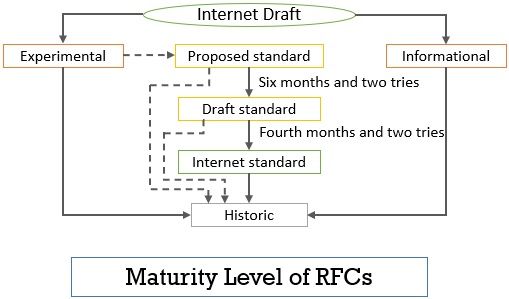Internet standard is a working document or a proposed specification that gains the status of the standard after proper validation and is applicable to the worldwide Internet. This Internet standard is formed under the supervision of the Internet Society (ISOC) which is responsible for the creation and implementation of Internet standards. In this section, we will discuss the ISOC organization, and we will also see the step-by-step formation of Internet standards.
Formation of Internet Society
Earlier there were no such organizations or committees that can define the internet standards. However, people around the world were doing their own thing to establish worldwide communication. This raises the need for standards that can be accepted across the world.
While working on ARPANET the Department of Defense (DoD) set up an informal committee i.e., the Internet Activities Board (IAB) which works to set up a network of the connected computer so that they can share their findings. This would also reduce and even eliminates the cost of duplication effort.
The acronym of IAB was modified to Internet Architecture Board (IAB). The IAB consisted of approximately ten members where each member was assigned a task, which they used to report to DoD. DoD and NSF used to raise the fund for IAB.
Whenever a new standard was required the members of IAB use it to discuss the requirements and announce this to the software graduate students to implement it with the help of coding. The communication between IAB and students was achieved with the help of series of online technical reports i.e., RFCs (Request For Comments). These comments are organized in serial order online and can be fetched by anyone who is interested in them.
With the continuous growth of the internet, IAB was reorganized in the year 1989. It was repopulated to form an organization which was then split into two groups, IRTF (Internet Research Task Force) and IETF (Internet Engineering Task Force). IRTF is held for conducting long-term research and IETF is held to handle short-term issues.
A year later an Internet society was for and populated with the people who were interested in the internet. The Internet Society emerges as an organization that was capable of creating standards for the internet. The trustees of the Internet Society then were responsible to appoint the members of IAB.
This is how the Internet Society (ISOC) was formed which thoroughly test and approved the proposed internet standards.
Internet Administrations
Just now we have seen the formation of ISOC (Internet Society). Well under ISOC there are various groups that coordinate to create and maintain the internet standards. In the figure below you can see the organization of all the groups under the ISOC.

Internet Society (ISOC)
The ISOC is an international organization that thoroughly test the proposed specifications before it is realized into the standard. Several administrative bodies such as IEFT, IA, etc. work cooperatively under the ISOC which is responsible to address all the issues that decide the future of the Internet. ISOC encourages scholarly activities and research in the field of the Internet.
IAB (Internet Architecture Board)
IAB issues technical advice to the Internet Society in order to ensure continuous growth of the Internet. IAB oversees the evolution of the Internet so that it becomes a global platform for communication.
IAB supervises two task forces namely IRTF (Internet Research Task Force) and IETF (Internet Engineering Task Force). IAB edits and manages the RFCs. IAB makes a connection between the Internet and other organizations that operate in the same direction.
Internet Research Task Force (IRTF)
IRTF conducts long-term researches related to the Internet. The research topic is related to Internet protocols, Internet applications, about their architecture. All the research groups involved in the research must have long-term membership. The research group (RG) or the working group under the IRTF is managed by the IRSG (Internet Research Steering Group).
Internet Engineering Task Force (IEFT)
IETF tackles short-term engineering problems subjected to the Internet. The working groups under IEFT are managed by the IESG (Internet Engineering Steering Group). The IEFT identifies the problems on the Internet and proposes a solution to resolve the problem.
IETF also reviews the proposed specifications which are capable of becoming the Internet Standards. Each working group is assigned a specific topic. The context of the assigned topic can be divided into nine categories such as application, Internet protocols, user services, Internet operation, routing, network management, transport, Internet protocol next generation, and security.
Studying the organization of Internet administration lets us study the process which every proposed specification must undergo before declared as an Internet standard.
Internet Standardization Process
Internet standards are those proposed specifications that are thoroughly tested for their successful implementation before they gain the status of Internet standard. Let us see the step-by-step procedure of the formation of Internet standards.
In the figure below we can observe level by level maturity of Internet standard.

A specification or statement or a working document is considered as an Internet draft that has no official status and has a lifetime of only six months. Upon approval by some Internet authorities, the Internet draft is published as Request for Comment (RFC). The RFCs are assigned a specific number and are available online for people interested in the Internet.
Every RFC before gaining the status of standard falls at least into one of the maturity levels below.
Maturity Level
1. Experimental
The published RFC is classified as experimental if it is applicable only in an experimental situation.
2. Informational
The published RFC is classified as informational if it is consists of any kind of information regarding the Internet. Usually, they put forth by non-Internet organizations such as vendors.
3. Proposed Standard
The RFC specification is classified as a proposed standard if it is well defined and has the work which seems to be of the Internet community’s interest. The specification here is examined and implemented by the different groups.
4. Draft Standard
Two successful implementations independent of each other and still interoperable promotes the proposed standard promote it to draft standard.
5. Internet Standard
Validation of successful implementation of a draft standard elevates it to Internet standard.
6. Historic
The Historic RFC are the specifications that are replaced by the newer specifications or those specifications that never reached the maturity levels that are required to gain the status of Internet standard.
The RFC itself can be of five different kinds on the basis of requirement.
Requirement Level
1. Required
The RFC is considered as required if it is mandatory to implement on all Internet systems to check whether it meets the specified standard. For example, ICMP an IP
2. Recommended
The RFC is considered as recommended if it is useful but is not mandatory to implement it on all Internet systems to check whether it meets the specified standard. For example, FTP and TELNET
3. Elective
The RFC is considered an elective if it can be used by an Internet system only for its own benefit.
4. Limited Use
The RFC is considered limited if can be used only in a limited situation. The RFC that are classified as experimental in maturity level is limited RFCs.
5. Not Recommended
The RFC is not meant for general use is not recommended RFC. Historical RFCs fall in this category.
So this is all about the Internet standards how they are formed, which committee is responsible for the creation, implementation, and maintenance of the Internet standards.

Leave a Reply